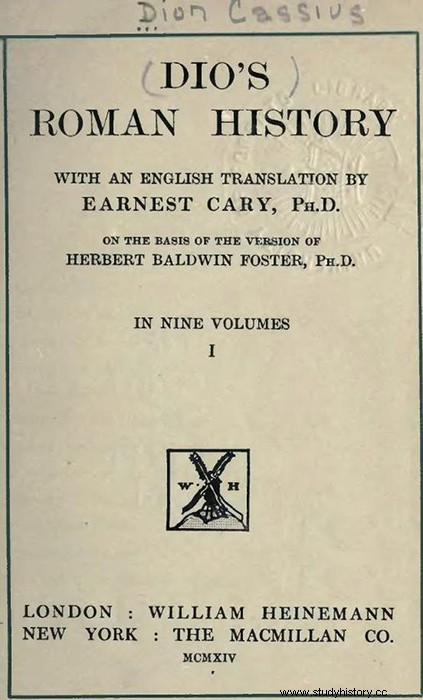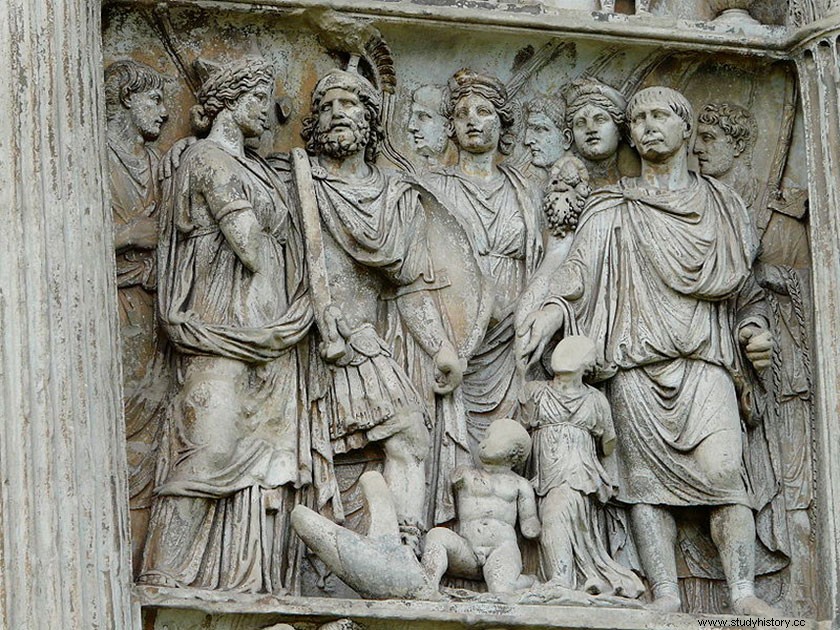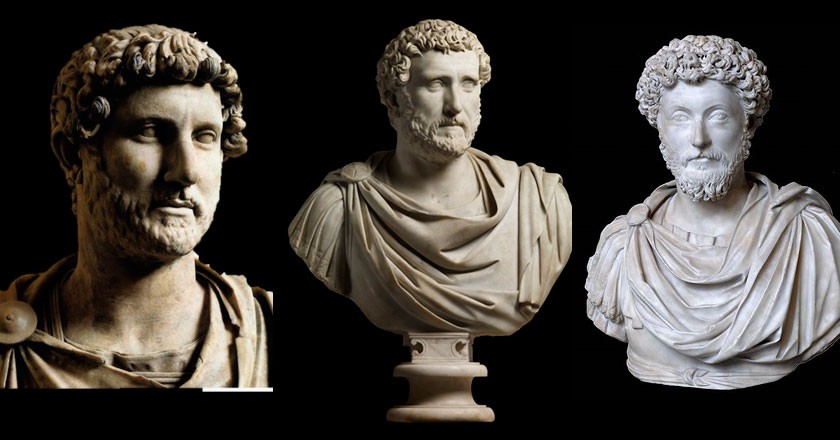
“May you be more fortunate than Augustus, and better than Trajan”
With this phrase were received, years after the death of Trajan, those invested with the Purple in Rome. Well, at least in the second part of the sentence we fear that it never came true.
Go ahead and write something new about Marcus Ulpius Trajan , after Santiago Posteguillo enlightened our lives with his trilogy about this Hispanic emperor, it is an almost impossible task, even so, it is worth recapitulating the main points about his history.
Sources to know about Trajan.
Given the barrage of information that we have today about Trajan, it should be noted that the primary literary sources, after losing at one point in history his memories , they are practically restricted to two:The closest to our character, the Letters of Pliny the Younger , where the writer of it conveys to the emperor her concern about the rapid growth of Christianity in the Roman Empire. The second term is the book LXVIII of the History of Rome, prepared by Dio Cassius . This Roman historian produced his work a century after the death of Trajan, during the mandate of Septimius Severus .

History of Rome, by Dion Cassius
The material culture has left us more clues than literature. There are many constructions of the time, in which we can glimpse episodes of the history of the emperor Trajan. Although of all of them we can mainly keep three:Trajan's Column , erected in the Roman forum of Trajan between the years 110-113, to commemorate the victories of the Empire in Dacian lands, nothing more and nothing less than 200 m of frieze with all kinds of details and the representation of Trajan himself in 59 images. We continue with the Adamclisi Trophy , a kind of tumular tomb built around the year 109 in what is now Romania, which was recovered at the beginning of the 20th century, and today its pieces occupy a large part of the museum in that Romanian city. Finally, highlight the Trajan's Arch in Benevento built on the Via Trajana between the years 114-117, thanks to which we know economic, political and religious aspects of the Empire, as well as the reforms of the ports of Ostia and Ancona.

On the right Trajan in the Arch of Benevento.
Numismatics It is undoubtedly the great source for the knowledge of the Imperial Propaganda during the mandate of Trajan. It is difficult to know the exact number of types of coins that could be minted during his reign. Suffice it as an example that during the years between the beginning of the two Dacian wars, that is, 101-105, up to 114 different types of coins have been located. In them we find reflected interesting data about religion, politics, economy or imperial conquests.
With all of them the current historiography and since the 19th century, it has been working out the details of the Roman Emperor's mandate. Let me in this aspect highlight the figure of José María Blázquez Martínez , Professor of Ancient History at the University of Salamanca and member of the Royal Academy of History. In my personal appreciation, one of the best examples of how to bring academic rigor closer to the general public, the one that today approaches the study of our past with curiosity.
The five good emperors.
Before fully speaking about our protagonist, a small paragraph to honor the title of our article today. Since during the nearly five centuries that the Western Roman Empire lasted, the period between the years 96-180 A.D., has been signified as that of the "Five Good Emperors ”, then Commodus arrived.
The Antonine Dynasty, or Ulpio Elia , as a large part of historiography defends calling it today, was born after three years of Domitian's ordeal, facing everyone; Senate, army, or his closest collaborators who killed him in 96 AD. C. From among them emerged the figure of Nerva , a 66-year-old man, who, in addition to stabilizing the Empire, brought about the greatest splendor of the Roman Empire, without a doubt his best decision to name Trajan as heir just one year after coming to power.
Next to Nerva (96-98) , and our protagonist Trajan (98-117) , second on the list, we find the following emperors:

Hadrian, on the left, introduced the beard among the Roman emperors, the others being Antoninus Pius and Marcus Aurelius.
Hadrian (117-138), the second Hispanic emperor, and always considered the antithesis of Trajan. He has continually been accused of pacifism due to the abandonment of the eastern front, or the construction of the famous wall of Britain. His tenure was noted for his love of art and culture, primarily Hellenistic. In addition, he is considered a tireless traveler, since he toured the provinces with the firm purpose of organizing the imperial administration. Impeccable legislator in matters of property and family.
Antoninus Pius (138-161), after the two Hispanics it was the turn of a Gaul, specifically from Nimes. Continuation of the policies of his predecessors, he raised the prominence of the Senate, endowing it with great powers, to exercise its role as advisers to the emperor. He surrounded himself with the best collaborators to have one of the most placid reigns of a Roman emperor. He cleaned up the coffers of the Empire and offered the most outstanding shows in Rome to the common people.
Marcus Aurelius (161-180), the philosopher emperor shared powers and titles in the early years of his rule with Lucius Verus (161-169) . He was not the best military man in Rome, but he knew how to surround himself with exceptional generals, his names Publius Helvio Pertinax, Septimius Severus or Pescenius Niger, transports us to his fight for the Empire after the death of Marcus Aurelius's successor. Despite his continuation policy of the Dynasty, he sees the first symptoms of the decline of the Empire, wars on the northern and eastern borders, bubonic plague and problems with monotheistic religions.
After this brief review, we can now give a brushstroke to the mandate of the best of the Five Good Emperors .
Marcus Ulpius Trajan
Born in Italica on September 18, 53, his father of the same name descended from an ancient Turdetan family, the Trahii. Meanwhile, his mother was a member of the Roman family of the gens Marcia.
Trajan's military career.
There is a great lack of information about the years of Trajan's military career. The first news places him at the age of 23 in Syria under the orders of his father. Hand in hand with his father, he visited the provinces farthest from Rome, to climb steps within the “ cursus honorum ”, including the named Syria, Asia or Africa. There is evidence that between 83-85 he was already serving as praetor.
Around the year 88, some sources place it in Hispania, specifically in the Tarraconesis , prepared the Legion VII Gémina, at the head of which the following year will abort the rebellion of Saturnio, the governor of the province of Germania Superior. The following two years he fought alongside his legion in the German limes of the Empire, which earned him the rank of Consul in the year 91. With this rank he will agree to govern Moesia Inferior and finally Germania Superior itself. from Mainz, where he learned from the mouth of his protégé Hadrian, the appointment of him as future emperor after Nerva's death.
The military emperor is born.
Without a doubt, this is Trajan's main quality; his mission as emperor to enlarge the Roman Empire. Which he achieved perfectly, since no one expanded further than him, the power of Rome. But as soon as you become an emperor, an aspect can attract our attention; After Nerva's death, far from returning to Rome right away, he decides to finish pacifying the Germanic limes, the question will always remain as to why he did not try to conquer Germany. Possibly the first lucubrations of him as emperor of Rome went through this possibility.
After leaving the German limes, he began his tour of other provinces, curiously the first visit will be to the place where he will consecrate himself as an excellent soldier. In the year 99 he visited Moesia and Pannonia, where a certain Decebalus Since the time of Domitian, he had become a headache for the Roman populations on the other side of the Danube. After knowing first-hand the problems of the Danubian limes, he decides to return to Rome, where he will spend a year putting his Roman policy into action.

Construction of the Trajan Bridge over the Danube
Between 101-102 he personally directs the war that subdued Decebalus, who has no choice but to kneel before the Roman emperor offering his obedience. But the Dacian must not have been very comfortable with the new situation, so he rises again in the year 106. Trajan prepared the second expedition conscientiously, mobilized no more and no less than 11 legions, two of them newly incorporated and with the unmistakable seal of Trajan, see Legion XXX Ulpia Victoriosa , and the strong Legion II Trajana . Decebalus's army was crushed, and he committed suicide before becoming a "vassal" of Trajan again. The empire crossed the natural border of the Danube for the first time, the riches and spoils that came from Dacia were celebrated for 123 days in the capital.
After the great victory in Dacia, the seven years that Trajan spent in Rome could seem eternal, in 113 he left for Antioch, following in the footsteps of Alexander the Great. The territories were falling on the side of Rome, at the same rate that the health of an exhausted Trajan fell. The truth is that the conquests practically reached the Persian Gulf, we will never know what would have happened if they had started earlier, or if his successor had been someone else. Arriving in India like Alexander would have been within his reach, but…

Trajan's Empire
The emperor of Rome.
The political Trajan does not detract from the military either. He highlights his excellent relations with the Roman Senate, headed by the so-called Hispanic Party. There were up to 27 Hispanic members of the Senate in Trajan's time, with his personal friend, Lucio Licinio Sura , as its reference. It is said that Trajan did not like receiving favors or continuous praise from the Senate.
Highlights his economic work at the head of the Empire, he picked up an organization created by his predecessors, the Food Institutions , to elevate them to the forefront of their economic policies. To improve agriculture, loans were offered to peasants at very low interest (there is talk of 5%, maximum), in addition the benefits went to the most needy layers of the population such as orphaned children. The cereal or the oil were distributed, as they appear in the Arch of Benevento, among the less wealthy families. Taxes remained very stable, the great benefits of the conquests were used for the common good.
Socially, his permissiveness with the different religions of the Empire stands out. The correspondence maintained with Pliny the Younger, is the best example of him, this indicates his fears regarding the proliferation of Christianity in the Roman provinces. His answers show that Trajan never thought that the monotheistic religion could be a problem for the Empire. Trajan's detractors embrace this point, as one of his biggest mistakes.
The buildings of Trajan's Empire.
The huge amounts of gold that came from the Dacian mines, was used in the time of Trajan to embellish the capital of the world. The forum that bore his name, the Basilica Ulpia , libraries, baths, an Odeon or the Trajan's market , are just a few examples that made Rome the most beautiful city in the world.
The borders of the Empire were reinforced with the construction of new cities such as Timgad in Africa, or Ulpia Trajana in the german limes. There was also a growing interest in the Mediterranean as the main means of communication, the extensions of the ports of Ostia, or Brindisi, being the best example of this. The imperial roads were repaired, such as the Vía de la Plata between Hispalis and Asturica Augusta , and new ones were carried out, with emblematic constructions such as the Puente de Alcántara , which still supports 21st century traffic today.

Recreation of the port of Ostia
Finally, note that there are few provinces in which we do not have today works promoted during Trajan's mandate. The new conquests were an open field for the new Roman roads that formed the backbone of Dacia, Arabia or Mesopotamia.
The death of Trajan.
Trajan never returned to Rome , on her way from Ctesiphon, the life of the best emperor that the Roman Empire has given died. His death remains a mystery, the worrying phrase that Dion Casio did not leave, remains a matter of controversy. (I invite you to read this article about the death of Trajan).
Trajan himself suspected that his illness was due to a poison that had been administered to him.
More info:
History of Rome, J. Cabrero and P. Fernández Uriel, Ed. Uued, 2008.
Trajano, José María Blázquez, Ed. Ariel, 2003.
penelope.uchicago
